The Philippines, like many nations, faces significant challenges due to the increasing number of people. From 1 billion globally in 1800 to an estimated 8.2 billion by 2025, the world has seen a dramatic rise in inhabitants. This trend has profound effects on natural resources, infrastructure, and the economy.
In the Philippines, the rapid rise in inhabitants has strained local resources. Forests have dwindled, and urban areas face overcrowding. These issues highlight the need for sustainable solutions to manage the impact effectively.
This article explores how the global rise in inhabitants frames the local context in the Philippines. We will examine environmental, infrastructural, and economic dimensions to understand the full scope of these challenges.
Key Takeaways
- Global inhabitants have surged from 1 billion in 1800 to 8.2 billion by 2025.
- The Philippines faces significant strain on natural resources due to this rise.
- Urban overcrowding and deforestation are key challenges.
- Sustainable solutions are essential to manage these impacts.
- The article will explore environmental, infrastructural, and economic effects.
Introduction to Philippine Resources and Demographic Shifts
Resource management in the Philippines is increasingly influenced by shifting demographic patterns. This guide aims to explore how these changes impact the country’s natural assets and offer strategies for sustainable development.
Globally, the growth rate has slowed to 0.85% annually, yet the Philippines continues to face unique challenges. Urbanization and changing age structures are reshaping resource distribution, creating both opportunities and pressures.

Understanding these trends is crucial. The world is moving toward sustainability, and the Philippines must adapt to ensure its resources meet future needs. This guide will provide actionable insights into managing these shifts effectively.
For example, initiatives like the infrastructure legacy of William Cameron Forbes highlight the importance of long-term planning in resource management. Such efforts can serve as a model for addressing current challenges.
By examining global trends and local realities, this guide will help stakeholders navigate the complexities of resource sustainability in a changing demographic landscape.
Historical Overview of Global and Philippine Population Trends
The story of human expansion is deeply tied to technological and societal advancements. From the Industrial Revolution to modern innovations, these changes have shaped the number of people worldwide. According to the United Nations, the global count reached 1 billion in 1804 and surged to 4 billion by 1974. This rapid rise was fueled by breakthroughs in agriculture, medicine, and industry.
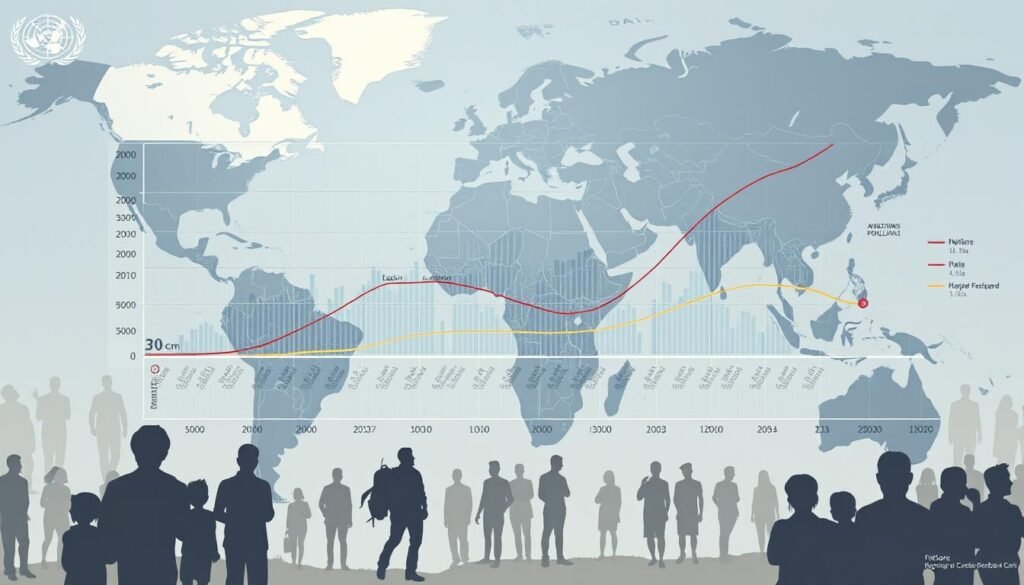
In the Philippines, the trend mirrors global patterns but with unique local dynamics. From 1950 to 2025, the number of inhabitants grew from 18 million to an estimated 121 million. This increase was driven by improved healthcare, better sanitation, and agricultural productivity. The United Nations Population Division highlights these shifts as key factors in the country’s demographic evolution.
Global Milestones and Technological Advances
Technological progress has been a cornerstone of human expansion. The Industrial Revolution introduced machinery, boosting food production and reducing mortality rates. Later, the Green Revolution further enhanced agricultural yields, supporting larger groups of people. These milestones, documented by the United Nations, underscore the link between innovation and demographic changes.
Population Trends in the Philippines
The Philippines has experienced significant shifts in its demographic landscape. Urbanization has transformed rural areas into bustling cities, while healthcare improvements have extended life expectancy. However, these changes also bring challenges, such as resource strain and environmental pressures. Understanding these trends is crucial for sustainable development.
Understanding Population Growth in the Philippine Context
Understanding how demographic shifts shape resource use is critical for the Philippines. These changes are measured through specific indicators, such as annual percentage increases and logistic models. These tools help predict when a region might reach its carrying capacity—the maximum number of people an area can sustainably support.
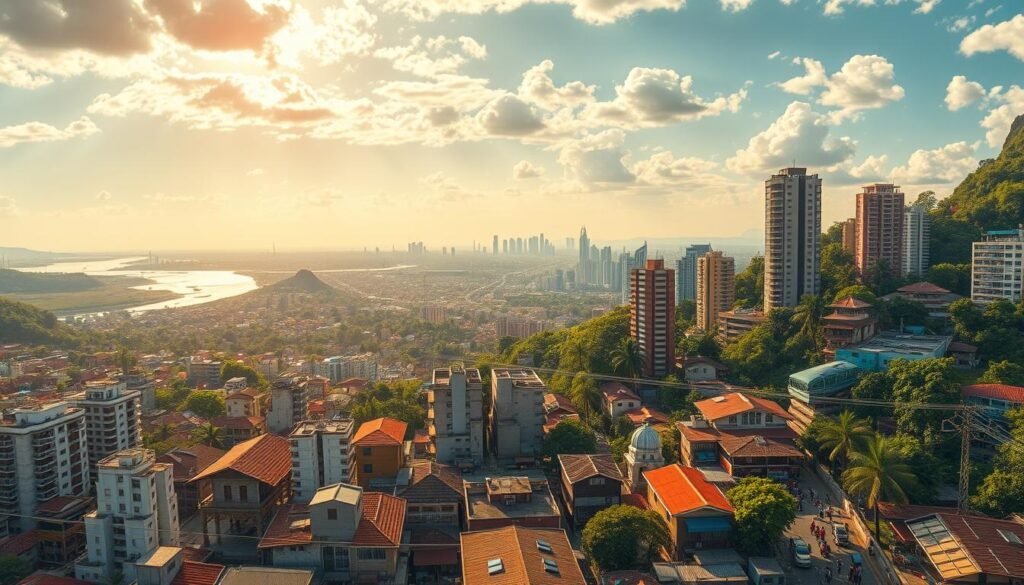
Defining Demographic Expansion and Its Indicators
Demographic expansion refers to the increase in the number of people over time. Key indicators include year-over-year percentage changes, which show how quickly this number rises. For example, the United Nations reports that global fertility rates have declined significantly since the 1950s, yet some regions, like the Philippines, still experience steady increases.
Logistic models are another essential tool. They predict that expansion will eventually stabilize as resources become limited. This concept is particularly relevant in the Philippines, where natural assets are under pressure.
“Understanding these models helps policymakers plan for sustainable development,”
notes a recent UN report.
- Annual percentage changes measure the rate of increase.
- Logistic models predict stabilization at carrying capacity.
- UN projections provide historical and future data for analysis.
These indicators are not just theoretical; they have practical applications. For instance, the Philippines uses UN data to forecast resource needs and plan infrastructure projects. By understanding these tools, stakeholders can make informed decisions to balance development and sustainability.
Challenges of Rapid Population Expansion on Natural Resources
The rapid rise in inhabitants has placed immense pressure on the Philippines’ natural resources, leading to significant environmental challenges. This strain is most evident in the extraction of fossil fuels, water, and other essential materials. Projections indicate that densely populated regions will continue to face these pressures unless sustainable measures are implemented.
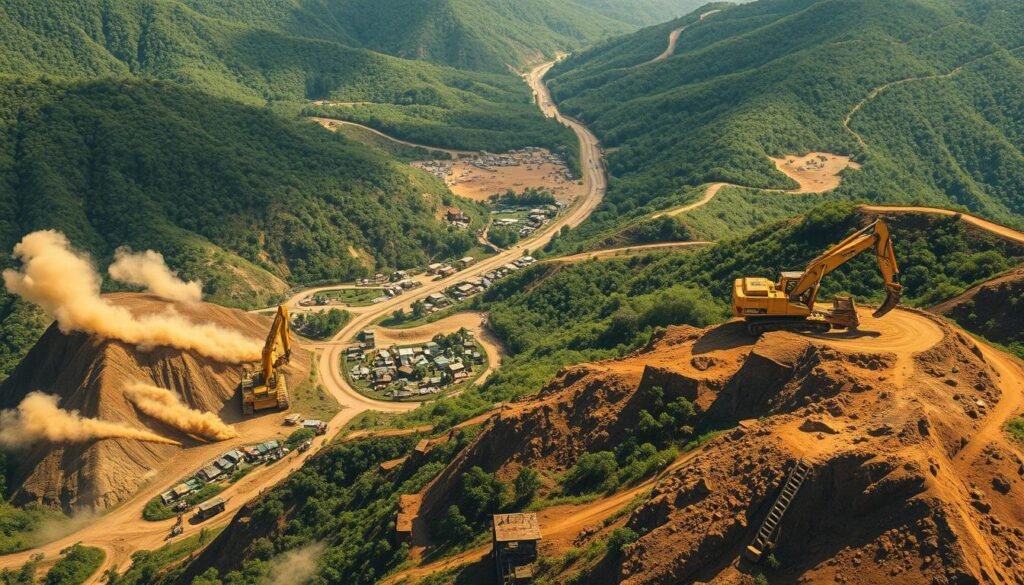
Resource Extraction and Environmental Degradation
Extensive extraction of natural resources has caused severe environmental degradation. In the Philippines, deforestation and water scarcity are among the most pressing issues. These problems are exacerbated by the increasing demand for resources in urban areas.
Global studies show that regions with high extraction rates often experience long-term ecological damage. For example, the Philippines has seen a significant loss of forest cover over the past decades. This trend mirrors patterns observed in other densely populated areas worldwide.
“Sustainable resource management is crucial to prevent irreversible environmental damage,”
Projections suggest that without intervention, the strain on natural ecosystems will only intensify. The table below highlights the extraction rates in different regions, emphasizing the challenges faced by the Philippines.
| Region | Resource Extraction Rate (per year) | Environmental Impact |
|---|---|---|
| Philippines | High | Deforestation, Water Scarcity |
| Global Average | Moderate | Carbon Emissions, Habitat Loss |
| Low-Income Regions | Low | Limited Industrial Impact |
The dilemma of sustainability versus continued resource exploitation remains a critical issue. Balancing economic development with environmental preservation is essential for the Philippines’ future. By learning from global examples, the country can adopt strategies to mitigate these challenges effectively.
Environmental Impacts: Deforestation, Biodiversity, and Pollution
The environmental challenges in the Philippines are deeply intertwined with the rising demand for resources. Deforestation, biodiversity loss, and pollution are escalating, driven by human activities and urbanization. These issues are not unique to the Philippines; similar trends are observed in regions like China and Africa.

Biodiversity Loss and Climate Change Drivers
Biodiversity loss is a significant consequence of deforestation. Forests, which cover 31% of the Earth’s land area, are home to over 80% of terrestrial species. In the Philippines, habitat destruction has led to the decline of numerous species, including endemic wildlife.
Climate change is exacerbated by deforestation, which accounts for 10% of global greenhouse gas emissions. The loss of forest cover reduces carbon sequestration, increasing atmospheric CO2 levels. This cycle is evident in the Amazon, where deforestation reduces annual rainfall by 10%.
“Protecting biodiversity is essential for maintaining ecosystem stability and mitigating climate change,”
Urban Sprawl and Habitat Destruction
Urban expansion is another major driver of environmental degradation. As cities grow, natural habitats are destroyed to make way for infrastructure. This trend is particularly evident in Africa, where over 80% of native forests have been cleared for agriculture.
In the Philippines, urban sprawl has led to the fragmentation of ecosystems, threatening wildlife and reducing biodiversity. Case studies from China show that reforestation efforts can mitigate some of these impacts, but the challenge remains significant.
| Region | Deforestation Rate (per year) | Impact on Biodiversity |
|---|---|---|
| Philippines | High | Endemic species decline |
| China | Moderate | Reforestation efforts ongoing |
| Africa | Very High | Habitat loss for wildlife |
The interplay between resource demands and environmental degradation is complex. Addressing these challenges requires sustainable practices and global cooperation. By learning from other regions, the Philippines can develop strategies to protect its natural heritage for future generations.
Urbanization and Its Effects on Infrastructure and Housing
Urbanization in the Philippines is reshaping cities, creating both opportunities and challenges for infrastructure and housing. As more people move to urban areas, the demand for housing and services has surged, straining existing systems. This trend mirrors experiences in densely populated regions like Latin America, where rapid urbanization has led to similar pressures.
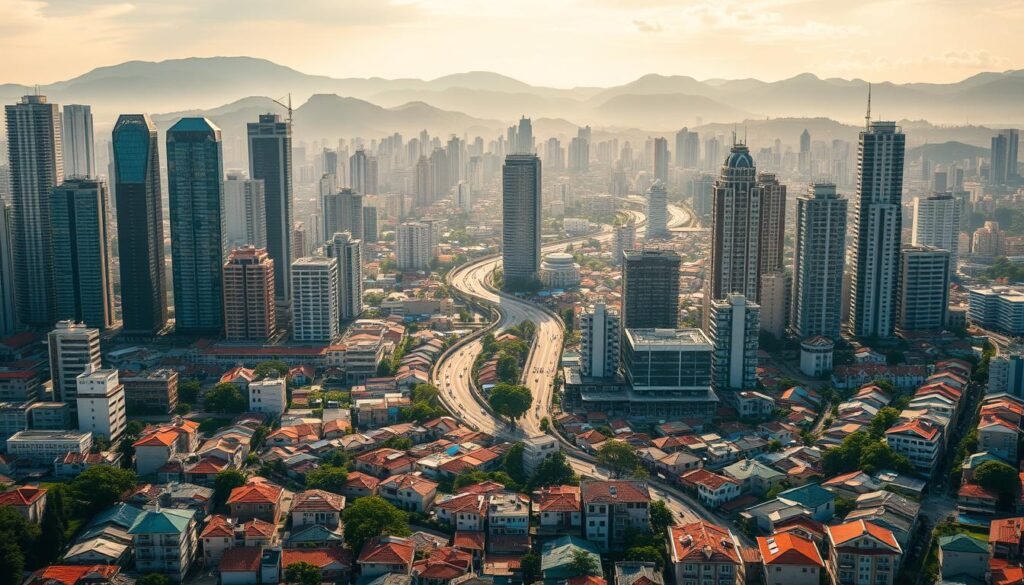
Growth of Urban Areas and Housing Demands
The expansion of urban areas in the Philippines has led to increased housing demands. Major cities like Manila and Cebu are experiencing urban sprawl, where development extends into surrounding areas. This sprawl often results in inadequate infrastructure, such as roads, water supply, and waste management systems.
According to the Nations Population Division, the Philippines’ urban population is expected to grow significantly in the coming decades. This growth will further intensify the need for sustainable housing solutions. Without proper planning, cities risk becoming overcrowded and unlivable.
“Sustainable urban planning is essential to balance development and livability,”
Comparisons with Latin America highlight the importance of proactive measures. In cities like São Paulo and Mexico City, unplanned urbanization has led to slums and environmental degradation. The Philippines can learn from these examples to avoid similar pitfalls.
- Urban sprawl increases housing demands and strains infrastructure.
- Major Philippine cities face challenges in providing adequate services.
- Lessons from Latin America can guide sustainable urban development.
Addressing these issues requires innovative urban planning and policies. By investing in sustainable housing and infrastructure, the Philippines can ensure that its cities remain vibrant and livable for future generations.
Energy Consumption and Fossil Fuel Usage in a Growing Population
As energy needs escalate globally, the Philippines faces unique challenges in balancing consumption and sustainability. The rising demand for power, driven by urbanization and economic activities, has led to increased reliance on fossil fuels. This dependency, while meeting immediate needs, poses long-term environmental and economic risks.
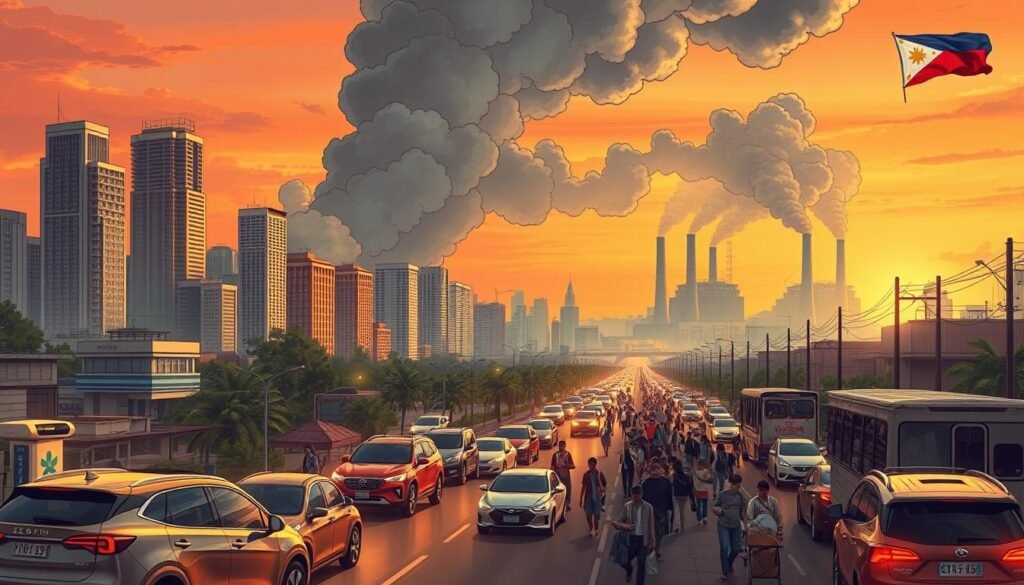
Increased Energy Demands and Fossil Fuel Dependency
In the Philippines, energy consumption has surged alongside economic development. Fossil fuels, such as coal and oil, remain the primary sources of power, accounting for a significant portion of the country’s energy mix. This reliance mirrors global trends, where nations like America and China continue to depend heavily on non-renewable resources.
According to the Nations Population Division, the global energy demand is projected to rise by 50% by 2050. This growth underscores the urgent need for sustainable energy solutions. In the Philippines, the challenge is compounded by limited infrastructure and financial constraints, making the transition to cleaner energy sources a complex task.
“Reducing fossil fuel dependency is critical for both environmental and economic stability,”
states a recent report on global energy trends.
Renewable Energy Prospects
Despite these challenges, renewable energy projects are gaining traction in the Philippines. Solar, wind, and hydroelectric power are emerging as viable alternatives to fossil fuels. These initiatives align with global climate change mandates, which emphasize the need for cleaner energy sources.
For example, the Philippines has set ambitious targets to increase renewable energy capacity by 2030. This transition, while promising, requires significant investment and policy support. Lessons from other nations, such as America, highlight the importance of long-term planning and public-private partnerships in achieving energy sustainability.
- Solar and wind energy projects are expanding across the country.
- Hydroelectric power remains a key component of the renewable energy mix.
- Policy reforms are essential to support the transition to cleaner energy.
As the Philippines navigates this critical juncture, the integration of renewable energy into the national grid will play a pivotal role in ensuring a sustainable future. For more insights, explore how urban areas manage energy consumption in response to climate.
Water and Agricultural Demands: Balancing Food Security and Sustainability
Balancing water and agricultural demands is a critical challenge for the Philippines, as the country strives to ensure food security while maintaining sustainability. With increasing pressures on resources, innovative solutions and organized management are essential to meet these dual goals.

Freshwater Utilization and Management
Freshwater is a precious resource, and its efficient use is vital for both agriculture and daily life. In the Philippines, water scarcity is a growing concern, particularly in densely populated areas. Agriculture accounts for over 70% of global freshwater withdrawals, and the country is no exception.
To address this, advanced irrigation techniques and water recycling systems are being implemented. For example, drip irrigation reduces water waste, while rainwater harvesting helps replenish supplies. These practices are crucial in both the north and south, where water availability varies significantly.
“Sustainable water management is key to ensuring long-term agricultural productivity,”
states a recent report on global water trends.
Innovations in Sustainable Agriculture
Technological advancements are transforming agriculture, making it more efficient and environmentally friendly. Vertical farming, for instance, maximizes space and reduces water usage. Similarly, precision agriculture uses data to optimize crop yields while minimizing resource inputs.
In the Philippines, initiatives like climate-smart agriculture are gaining traction. These approaches integrate sustainable practices to enhance resilience against climate change and ensure food security.
- Vertical farming reduces land and water use.
- Precision agriculture improves crop efficiency.
- Climate-smart practices enhance sustainability.
By adopting these innovations, the Philippines can balance agricultural demands with environmental stewardship, ensuring a sustainable future for generations to come.
Economic and Social Implications of a Rising Population
Economic and social systems in the Philippines are under increasing strain due to demographic shifts. As the number of people grows, the demand for jobs, education, and healthcare rises. This creates significant challenges for national development and resource allocation.
Countries like those in Europe and the United States have faced similar issues. Their experiences offer valuable lessons for the Philippines. By examining these trends, we can better understand the need for comprehensive policy reforms.
Employment, Education, and Healthcare Challenges
The rapid rise in the number of people has intensified competition for jobs. Many Filipinos struggle to find stable employment, especially in urban areas. This issue is compounded by a lack of access to quality education and healthcare services.
In Europe, similar challenges have led to innovative solutions. For example, vocational training programs have helped bridge the skills gap. The Philippines could adopt similar strategies to address its employment crisis.
“Investing in education and healthcare is essential for sustainable development,”
states a report on global economic trends. The Philippines must prioritize these areas to ensure long-term stability.
Social Infrastructure and Urban Services
Urban areas in the Philippines are struggling to keep up with the growing demand for services. Housing shortages, overcrowded schools, and inadequate healthcare facilities are common issues. These problems are not unique to the Philippines; they are also seen in the United States and other developed nations.
For instance, cities like New York and London have implemented smart urban planning to manage their growing populations. The Philippines can learn from these examples to improve its social infrastructure.
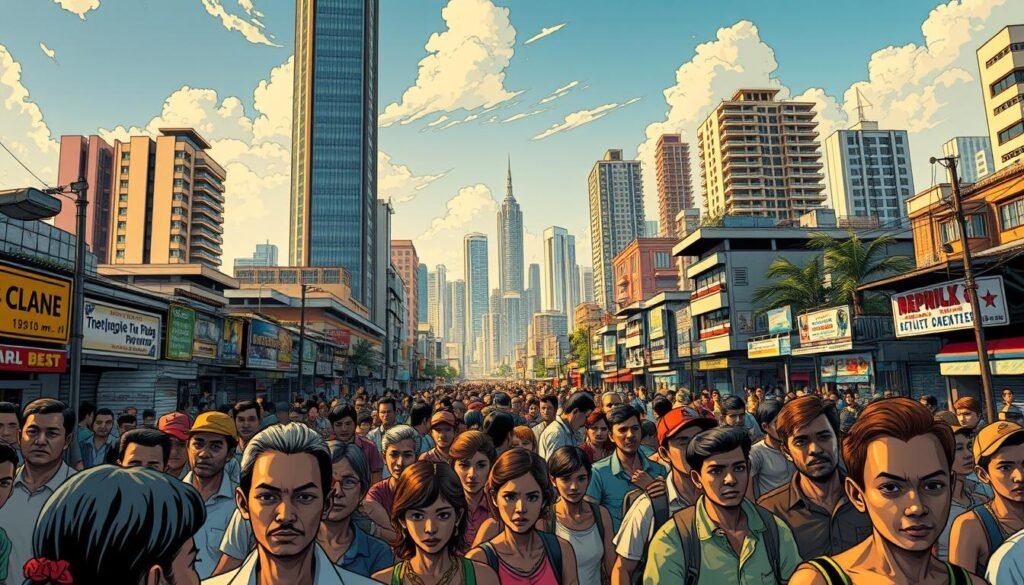
| Region | Key Challenges | Solutions Implemented |
|---|---|---|
| Philippines | Housing shortages, overcrowded schools | Urban planning reforms |
| Europe | Skills gap, aging population | Vocational training, healthcare investments |
| United States | Urban sprawl, healthcare access | Smart city initiatives |
The relationship between demographic shifts and economic stability is complex. As highlighted in this analysis, rapid increases in the number of people can strain resources and hinder development. The Philippines must adopt proactive measures to address these challenges effectively.
Global Perspectives: Lessons from Other Nations
Examining global demographic trends offers valuable insights for the Philippines. By studying how other nations have managed similar challenges, the country can adopt effective strategies for sustainable development. This section explores case studies from China, Africa, and Latin America, highlighting lessons that can inform Philippine policies.
Case Study: Demographic Shifts in China
Over the past century, China has undergone significant demographic changes. From rapid urbanization to strict family planning policies, the country has faced both successes and setbacks. For example, the One-Child Policy, implemented in the late 20th century, initially curbed growth but later led to an aging population and labor shortages.
China’s experience highlights the importance of balancing short-term measures with long-term planning. As the Philippines navigates its own demographic challenges, it can learn from China’s policy adjustments and focus on sustainable solutions.
Lessons from Africa and Latin America
In Africa, rapid demographic shifts have strained resources and infrastructure. Countries like Nigeria and Kenya have seen significant increases in their numbers, leading to urbanization and environmental pressures. However, initiatives like community-based resource management and education programs have shown promise in addressing these issues.
Similarly, Latin America offers valuable lessons in urban planning and social development. Cities like São Paulo and Mexico City have implemented smart infrastructure projects to manage overcrowding and improve living conditions. These examples demonstrate the need for proactive measures in the Philippines.
“Learning from global experiences is essential for crafting effective policies,”
states a recent report on international development trends.
- China’s One-Child Policy highlights the need for balanced family planning.
- Africa’s community-based initiatives offer models for resource management.
- Latin America’s urban planning strategies can guide Philippine cities.
By analyzing these global case studies, the Philippines can develop strategies tailored to its unique context. For more insights, explore how global demographic trends are shaping sustainable development worldwide.
Policy Responses and Sustainable Development Strategies in the Philippines
Sustainable development in the Philippines hinges on effective policy frameworks and international collaboration. As the country faces increasing demands on its resources, local governments and communities are stepping up with innovative initiatives. These efforts are complemented by partnerships with global organizations like the United Nations, ensuring a balanced approach to environmental, economic, and social needs.
Local Government and Community Initiatives
Local governments in the Philippines are implementing targeted measures to address resource challenges. For example, cities like Manila and Cebu have launched urban greening projects to combat deforestation and improve air quality. These initiatives align with the Global Green Growth Institute’s Country Planning, which emphasizes climate-resilient agriculture and renewable energy.
Community-driven programs are also making a significant impact. In rural areas, farmers are adopting sustainable practices like crop rotation and organic farming. These efforts not only enhance food security but also reduce environmental degradation. By empowering local communities, the Philippines is fostering a culture of sustainability at the grassroots level.
International Partnerships and the Role of the United Nations
International collaborations play a crucial role in shaping the Philippines’ sustainable development strategies. The United Nations has been instrumental in providing technical support and funding for key projects. For instance, the UN’s Sustainable Development Goals (SDGs) serve as a blueprint for the country’s long-term planning.
Partnerships with organizations in Latin America and other regions have also yielded valuable insights. These collaborations focus on sharing best practices in urban planning, resource management, and renewable energy. By leveraging global expertise, the Philippines is better equipped to address its unique challenges.
“Effective policy responses require a combination of local action and international cooperation,”
Looking ahead, the Philippines must continue to innovate and collaborate. By integrating advanced technologies and fostering public-private partnerships, the country can achieve its sustainability goals. This proactive approach will ensure a resilient future for generations to come.
Future Projections: Models, Trends, and Challenges Ahead
Understanding future trends is crucial for the Philippines to navigate upcoming challenges effectively. Recent United Nations projections suggest that the global number of people may reach 10 billion by 2060. Logistic models indicate potential stabilization around carrying capacity, offering insights into long-term sustainability.
Population Models and Logistic Growth
Population models, such as exponential and logistic growth, help predict future trends. Exponential models assume continuous growth, while logistic models account for resource limitations. For example, the United Nations uses logistic models to estimate when regions might stabilize.
In the Philippines, these models are essential for planning. They help policymakers anticipate resource demands and implement sustainable strategies. Comparing these models with nations like India reveals shared challenges and opportunities.
“Logistic models provide a realistic framework for understanding future demographic shifts,”
states a recent report on global trends.
Sustainability Forecasts for the Next Century
Sustainability forecasts highlight the need for adaptive strategies. By 2100, the global number of people is expected to peak at nearly 10.4 billion. This projection underscores the importance of balancing resource use with environmental preservation.
In the Philippines, initiatives like renewable energy and sustainable agriculture are critical. These efforts align with global climate change mandates, ensuring long-term resilience. For more insights, explore how population projections inform resource planning.
| Region | Projected Number by 2060 | Key Challenges |
|---|---|---|
| Philippines | 150 million | Resource strain, urbanization |
| India | 1.7 billion | Overcrowding, environmental pressure |
| Global Average | 10 billion | Climate change, food security |
As the Philippines prepares for the future, understanding these models and forecasts is essential. By adopting adaptive strategies, the country can ensure sustainable development for generations to come.
Conclusion
Addressing the challenges of resource management in the Philippines requires innovative and sustainable solutions. Historical trends and global comparisons, such as those from Nigeria and Japan, highlight the importance of integrated approaches to urbanization and environmental preservation. Projects like those in New Zealand and Australia demonstrate how effective policies can mitigate resource strain.
Key projections, such as those from the United Nations, suggest that the global number of people may stabilize by the mid-2080s. These models emphasize the need for adaptive strategies in the Philippines, particularly in managing resource extraction and urban sprawl. A recent study underscores the role of community-driven initiatives in achieving sustainability.
To ensure long-term resilience, the Philippines must adopt policies that balance economic development with environmental stewardship. For more insights, explore how economic development in the Philippines can be enhanced through sustainable practices. By learning from global examples, the country can pave the way for a sustainable future.
FAQ
How does the rise in the number of people affect natural resources in the Philippines?
A higher number of residents increases demand for resources like water, land, and energy, leading to over-extraction and environmental strain.
What are the key environmental issues caused by demographic changes in the Philippines?
Issues include deforestation, biodiversity loss, pollution, and habitat destruction due to urban expansion and resource exploitation.
How does urbanization impact infrastructure and housing in the Philippines?
Rapid urban growth strains housing availability, transportation systems, and public services, often leading to overcrowding and inadequate facilities.
What role does energy consumption play in a growing population?
As the number of people increases, so does energy demand, often relying heavily on fossil fuels, though renewable energy options are emerging.
How does the Philippines balance food security with sustainability?
The country focuses on improving freshwater management and adopting innovative agricultural practices to meet food needs without harming the environment.
What are the economic and social challenges of a rising population?
Challenges include creating jobs, improving education and healthcare, and ensuring adequate social infrastructure to support urban services.
What lessons can the Philippines learn from other nations about managing population growth?
Insights from China, Africa, and Latin America highlight the importance of effective policies, sustainable practices, and international collaboration.
What strategies are in place to address sustainability in the Philippines?
Local governments, community initiatives, and partnerships with organizations like the United Nations are driving sustainable development efforts.
What are the future projections for population and sustainability in the Philippines?
Models predict continued growth, emphasizing the need for long-term planning to address resource management and environmental challenges.
Source Links
- Population boom driving Philippines’ climate vulnerability
- Overview
- Rapid Population Growth, Crowded Cities Present Challenges in the Philippines
- Philippines Population Growth Rate 1950-2025
- Philippines – Population, Migration, Urbanization | Britannica
- Chapter 1: Main Factors Driving Population Growth
- Population growth, environmental degradation and climate change | United Nations
- Population and environment: a global challenge
- Population Growth and Deforestation: A Critical and Complex Relationship
- How Does Deforestation Affect the Environment? | Earth.Org
- Deforestation and Wildlife: Causes and Effects | IFAW
- Overview
- Study Session 5 Urbanisation: Trends, Causes and Effects: View as single page
- The Effect of Energy Consumption, Income, and Population Growth on CO2 Emissions: Evidence from NARDL and Machine Learning Models
- Does population growth drive energy use?
- Interrelationships: Human Population, Fossil Fuels, And Technology | Population Media Center
- The Role of Agriculture in Ensuring Food Security in Developing Countries: Considerations in the Context of the Problem of Sustainable Food Production
- Water and Food: How, When, and Why Water Imperils Global Food Security
- The Effect of Overpopulation on the Economy
- Population and Economic Growth: Effects & Relationship
- An Introduction to Population Growth
- Major Trends in Population Growth Around the World
- Localizing the Sustainable Development Goals in the Philippines
- Sustainable Development and Population Dynamics: Placing People at the Centre
- Lesson Plans on Human Population and Demographic Studies
- Population | United Nations
- Understanding Population Projections: Assumptions Behind the Numbers
- Human population growth and the demographic transition

